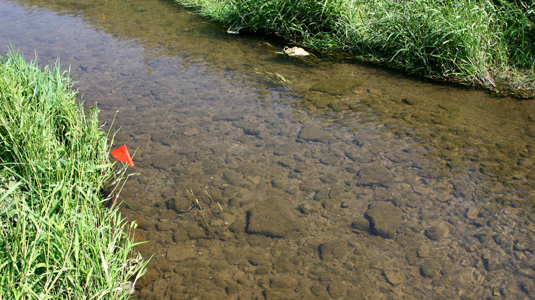Predicting Changing River Landscapes
Aaron Packman combines observations and mathematic models to evaluate the river’s future.

Rivers are an important part of our everyday lives. They provide water for drinking and irrigation and transport for trade and travel. They are used to generate electric power for energy and act as habitats for diverse plants and animals.
When a river physically or chemically changes, it can disrupt people, wildlife, and industry. If we could predict when and how these changes will occur, then we could better prepare—or even manage rivers in a sustainable way to maintain all their important functions.
Northwestern University’s Aaron Packman and his team are working to create tools that can predict how a river’s water level, course, and toxicity will change in the future. The project, called Earthcasting, works across the boundaries of physical and chemical experiments and theory—combining observations in the natural environment with the development of new mathematic models. It is an interdisciplinary, collaborative study among Northwestern, the University of Notre Dame, Michigan State University, and the University of Pennsylvania.
 “Rivers are quite hard to predict compared to other systems,” says Packman, a professor of civil and environmental engineering. “Current mathematics aren’t sufficient to study this complex environmental system behavior, but we are linking mathematics, physics, and geochemistry to create a better model.”
“Rivers are quite hard to predict compared to other systems,” says Packman, a professor of civil and environmental engineering. “Current mathematics aren’t sufficient to study this complex environmental system behavior, but we are linking mathematics, physics, and geochemistry to create a better model.”
Packman’s group at Northwestern’s McCormick School of Engineering and Applied Science bridges the gap between mathematics and experimental work to develop computational models that will improve our capability to predict river ecosystem dynamics.
To do this, he and other researchers look at long-term trends, such as climate change, coupled with more variable trends, such as day-to-day weather. They must also take into account how humans alter a river’s landscape by implementing locks and dams, removing water for drinking and irrigation, and changing nutrient levels through widespread use of fertilizers.
“Humans have the ability to rewrite the landscape through engineering and technology,” Packman says. “Globally humans have doubled the amount of nitrogen [from fertilizers] that’s coming out of major rivers. We’ve really changed the global process.”
To predict rapid changes to river environments, the project relies on a combination of mathematical modeling, computer simulations, and environmental observations to create an entire picture of river behavior. The Earthcasting team is actively working with groups in the United States and Europe who are collecting water, soil, and sediment samples along river channels and floodplains. The researchers plan to build a record over a long period of time that allows trends to be assessed.
“We can’t just make one set of measurements and understand the system behavior,” Packman says. “The problem we have today is that there are so many long-term data records that are low frequency. There might be only one measurement per month. But these infrequent measurements miss the effects of storms that cause sudden changes in river behavior.”
The end result of the Earthcasting project will be a software package that can be continually updated as more data becomes available. With the software, users can simulate different environmental or manmade factors to better understand the basic processes that occur in—and view the predicted future of—their particular river of interest. Packman expects it will be used by other scientists studying rivers, water resource managers, farmers, and people trying to maintain the navigability of rivers. He also hopes it will be used by legislators making major decisions about rivers.
“For example, there’s a discussion right now about re-reversing the Chicago River,” Packman says. “That’s a really big decision that needs more information.”
This project is funded by the National Science Foundation. Other principal investigators on the project include Diogo Bolster and Jen Tank of the University of Notre Dame, Mark Meerschaert of Michigan State University, and Doug Jerolmack of the University of Pennsylvania.